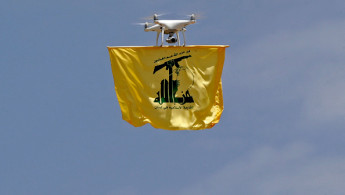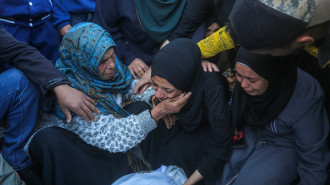No more 'mowing the grass': Hezbollah's arsenal presents new deterrence to Israel
Over the last eight months of war, Hezbollah has increased its deterrence against an Israeli ground invasion of southern Lebanon, primarily through its steady unveiling of an unexpectedly modern arsenal.
Previously, the Israel-Lebanon border had maintained an uneasy calm, punctuated by the occasional exchange of rockets into empty areas.
The memories of the July 2006 war between Israel and Hezbollah taught the former that it could not occupy southern Lebanon, and the latter that Israel could wreak immense destruction in a short period of time.
Not wanting to confront Hezbollah head on, Israel's efforts then concentrated on ensuring that the Lebanese group's capabilities did not grow.
As Iranian militias proliferated in Syria and the country's military was devastated after the 2011 uprising, Israel opened a theatre against Hezbollah in neighbouring Syria. Israel carried out hundreds of air strikes, with a primary aim of disrupting the "land corridor" from Iran to Lebanon, from which Iran supplied Hezbollah with weaponry. On occasion, it would kill Lebanese Hezbollah fighters as well.
This remained the status quo, with Israel seeking carrying out occasional strikes to constrain Hezbollah's growth, until the 7 October 2023 surprise attack led by Hamas.
The subsequent cross-border clashes between Israel and Hezbollah have given the opportunity for each to redefine both the rules of engagement and how their combat capacities stack against one another.
The extent of Hezbollah's technological capacity has stunned observers, showing a disciplined army with an extensive arsenal, a far cry from the fledgling resistance group from which it started. It is expected that Hezbollah has more weaponry that it has yet to reveal if the conflict should escalate further.
Anti-aircraft, advanced aircraft
On June 7, Hezbollah released a statement declaring that for the first time in its history, it had forced an Israeli jet to retreat back across the border by firing an anti-aircraft missile at it. A few days later, a video was filmed, purportedly showing the group once again firing an anti-aircraft missile at a jet which broke the sound barrier.
The revelation that Hezbollah had anti-aircraft missiles, though the specification of the missile was not released, changed the evaluation of the Lebanese group's military capacities. According to a report, 22,111 Israeli military airspace violated Lebanese airspace between 2007 and 2022.
Prior to the advent of the new anti-aircraft missile, Hezbollah's most advanced air defence feat was the downing of an Israeli helicopter in the 2006 war – something which does not require advance weaponry.
Hezbollah's possession of more sophisticated anti-aircraft technology would mean Israel could not conduct aerial sorties over the country with abandon as it previously had.
The group has also proven itself adept at downing Israeli drones, destroying several with what Israeli media had reported as an Iranian Saqr missile. The Saqr missile is a loitering munition that waits in the sky until a target comes into view, it reportedly has also been used by the Houthis in Yemen to down an American drone.
Just as significant as Hezbollah's new anti-aircraft capacity is its new drone fleet.
On Tuesday, Hezbollah released a ten-minute long video of a drone flying over Haifa at a seemingly leisurely place, identifying military targets, and returning to Lebanon without activating Israel's air defences.
The drone video proved to Israel that Hezbollah had the capacity to penetrate deep into its territory without being detected. Though this was a surveillance drone, the prospect of a suicide drone or drones carrying warheads hovering over Haifa has a significant psychological potency to both the civilian residents of Haifa and the Israeli military.
It also demonstrates the extent of Hezbollah's intelligence gathering within Israel. Hezbollah chief Hassan Nasrallah boasted about this in a speech on Wednesday, saying the group had a "complete bank of targets" all over Israel in the case of an all-out war.
Before the drone video was published, Hezbollah told journalists to note in their analysis that its release was deliberately timed to coincide with US mediator Amos Hochstein's visit to Beirut.
"The very fact that Hezbollah chose to share the video at a critical time signals that they are digging in their heels and embracing the possibility of war," Amal Saad, a lecturer at Cardiff University and expert on Hezbollah, told The New Arab.
"If Israel had any doubts that Hezbollah was serious about this red line, these doubts should now end, leaving Israel to decide whether it is willing to escalate further," Saad said.
How will this affect Israeli plans for an offensive in Lebanon?
In recent weeks, Israeli officials have publicly discussed the possibility of an offensive in Lebanon, saying that if no diplomatic solution to Hezbollah's presence on the border is found, it will take action. On Tuesday, Israel said it had approved an "operational plan" in south Lebanon.
It is unclear what an expanded Israeli offensive in south Lebanon would look like, but it would likely centre around an intense aerial campaign encompassing broad swathes of south Lebanon and the Bekaa valley.
The nominal aim of the campaign would be to degrade Hezbollah capabilities and put an end to the firing of anti-tank, Katyusha and other low-flying rockets that Hezbollah has been using to evade Israeli air defences. This would involve creating a sort of security zone of at least 7 to 11 kilometres along the Israel-Lebanon border, the range of the above weapons.
Given Israel's lack of success in defeating Hamas in the Gaza Strip over the last eight-and-a-half months, it is unlikely that it would be able to have better chances with Hezbollah in south Lebanon. The Lebanese group is bigger, better equipped and trained and is spread out over a wide area with more challenging topography than the cramped Gaza Strip.
If not definitively defeating Hezbollah, Israeli officials could be trying to employ its policy of "mowing the grass." The term emerged to describe Israel's strategy towards Hamas in Gaza, periodically conducting short but intense military campaigns in Gaza to re-establish deterrence and degrade the militant group's capabilities.
However, new feats of military showmanship by Hezbollah might give pause to Israeli plans to "mow the grass" in Lebanon. Unlike in Gaza, where it is largely an asymmetric war against Hamas and civilians, Hezbollah could exact a heavy toll on Israel.
If the rhetoric from Hassan Nasrallah is to be believed, a war with Israel would mean missiles raining down on Tel Aviv and a multi-front war with allied groups in Iraq, Syria and Yemen.
These threats, and the more complex attacks being carried out by Hezbollah on Israel, are designed to increase the anticipated cost of an Israeli offensive in Lebanon. They are signals meant to tell Israel that it cannot merely "mow the grass" in Lebanon and expect to emerge unscathed.




 Follow the Middle East's top stories in English at The New Arab on Google News
Follow the Middle East's top stories in English at The New Arab on Google News
![A group of Palestinians, foreign and Israeli activists gather to participated in an olive picking event on the land in the town of Battir, which is under threat of confiscation by Israel in Bethlehem, occupied West Bank on 8 November 2024. [Getty]](/sites/default/files/styles/image_330x185/public/2182930803.jpeg?h=199d8c1f&itok=__0LgGsa)

![People gathered around the rubble of destroyed houses to search for survivors [Getty]](/sites/default/files/styles/image_330x185/public/2024-11/GettyImages-2184733820.jpg?h=199d8c1f&itok=NiM1LO2f)